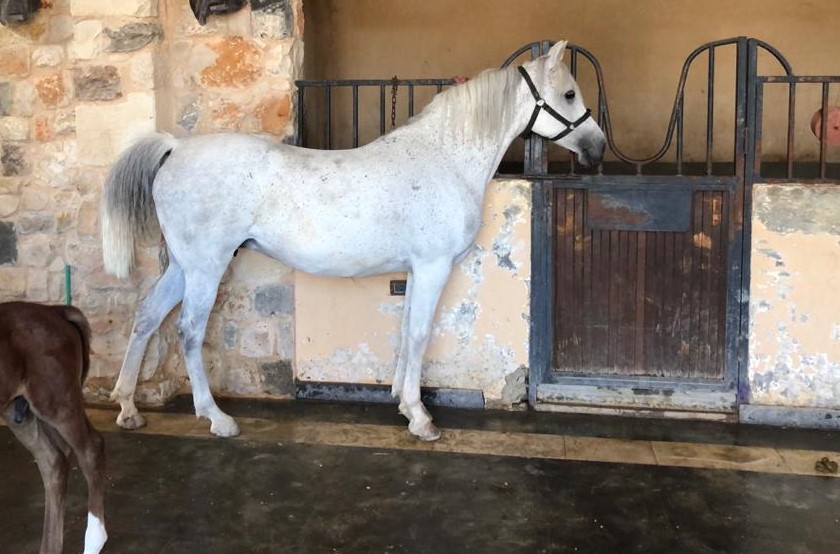Dating the Kuhaylan Mimrah strain: 1495 CE
Some twelve years ago, I wrote several blog entries about the strain of Kuhaylan al-Mimrah. One of these entries, here, summarized the strain’s origin as it was reported in one account in the Abbas Pasha Manuscript. This account traced this strain’s origin to a Kuhaylat al-‘Ajuz mare owned by ‘Ijl Ibn Hulaytim, a celebrated figure in the history of Najd. He was from the old tribe of Aal Mughirah. Aal Mughirah, now vanished as a single tribal unit, was one of the sections of the larger Bani Lam tribe.
‘Ijl was the ruler (amir) of a small but powerful principality in Najd centered around the town of al-Shu’araa, some 200 kilometres west of Riyadh, the capital of Saudi Arabia. The second map zooms in on the black box area in the first map, enlarged. Ignore the red point.




According to this account, a precious, ancient line of Kuhaylat al-‘Ajuz had passed in war from ‘Ijl ibn Hulaytim to the tribe of Qahtan, then from Qahtan to al-Maryum, who was from the Dhafeer tribe. From al-Maryum, it had passed to al-Mimrah, who was from the clan of al-Muwayni’ of the Sba’ah. The line has been known as Kuhaylat al-Mimrah ever since. This is my partial translation of the account in the Abbas Pasha Manuscript:
Chapter Two, on Kuhaylat al-Maryum and she is Kuhaylat al-Mimrah
Sultan Ibn Suwayt, the shaykh of al-Dhafeer was queried about Kuhaylat al-Maryum and Kuhaly al-Mimrah at a gathering, “because it is said it is yours O Dhafeer”. Sultan Ibn Suwayt and Dahsh al-Khishm, the son of the paternal uncle of Diab al-Maryum of al-Suwayt reported that: “al-Maryum is ours O Dhafeer. As to al-Mimrah, [this is how] she is called in the North. The al-Mimrah [strain] is the brother of the al-Maryum [strain] [my note: that’s a metaphor, meaning the two strains are one and the same]. The horses of al-Mimrah are from al-Maryum.
Al-Maryum is a Kuhaylat ‘Ajuz of the most ancient horses. There is no need to tell stories to trace her. The original stud she first spread from is with al-Mughira, one of the ancient tribes. From what we have heard and what is confirmed with us, she passed from al-Mughira when ‘Ijl Ibn Hulaytim raided Qahatan at dawn. She became with Qahtan since that time.
Al-Maryum raided Qahtan, during a time we have no recollection of. He took her [literally, “plucked her out”] from Qahtan during the time of our forefathers. In his ownership, she was named al-Maryum, after his name, but she is otherwise Kuhaylat ‘Ajuz of the foremost and most ancient strain of horses. She passed from al-Maryum of al-Dhafeer to al-Mimrah of al-Sba’ah, during an ancient time we have no recollection of, we O those present [here]. The strain was cut from al-Dhafeer and there became horse from it with al-Sba’ah […].
[…] We ask God Most High that he bring us a line from them [..]. From the time we have recollection of until now, we have not heard that anything had passed from this strain to outsiders, except from al-Maryum of al-Dhafeer to al-Mimrah of al-Sba’ah, and [Kuhaylat] al-Mimrah is from [Kuhaylat] al-Maryum. These are her accounts.
The account is repetitive, but it does emphasize how old and precious that strain was. Twelve years ago, I had speculated that ‘Ijl Ibn Hulaytim lived in the XVIIth century. I can now confirm that he lived well before that time. The old chronicles of the Hijaz indeed ascribe the peak of his career to the end of the ninth century and the beginning of the tenth century Hijri, around 1500 CE. They record him as ‘Ijl (or ‘Ajlan) Ibn Hulaytim of the clan of Aal Ghadfaa of the tribe of Aal Mughirah of Bani Lam. These chronicles relate several episodes of warfare between ‘Ijl Ibn Hulaytim and the Sharif Barakat II of Mecca, who ruled Mecca between 1473 and 1525 CE.
One of these episodes is noteworthy because it mentions horses. It is related by Meccan chronicler ‘Izz al-Din al-Hashimi al-Qurashi, in his Ghayat al-Maram bi-Akhbaar Saltanat al-Balad al-Haraam, under the events of the year 900 Hijri (1494-95 CE). My translation of this episode follows:
On the eleventh of the month of Rajab, the Sharif of Mecca marched towards the East [i.e., Najd, east of Mecca] to raid some Arabs from the Bani Lam.
Their country had became barren, so they had endeavored to pasture their flocks in the territory of the Sharif. The name of their Shaykh was ‘Ijl. There had been a feud between him and others from his own people, which is also why he had been driven out there.
He [‘Ijl] had around four hundred horsemen with him, perhaps more. He [‘Ijl] sent his son and his brother to the Sharif to ask him for permission [to pasture his flock]. The Sharif learned that the two were on their way, so he sent someone to kill the envoys of Bani Lam.
The Sharif, and with him Bani Hussain and ‘Adwan, then mounted a surprise attack against them in the morning, near al-Sayl, only to find out that they had received a warning the night before. The men had retreated on their horses, leaving their families and most of their possessions behind.
The Sharif lamented letting their shaykh [i.e., ‘Ijl] escape, because he [‘Ijl] had been one of those who had surrounded the Sharif and his troops towards the East some time ago, wanting to capture them. Back then, the Sharif had appeased their shaykhs with a lot of his money and possessions. They were three [shaykhs] including ‘Ijl.
The Sharif had written to one of the religious judges of Mecca, telling him that he had taken from them [the people of ‘Ijl] more booty than he or his forebears had ever taken before. There was so much ghee that it flowed when it was poured, the camels taken were more than twenty thousand, and the horses three hundred.
Another chronicler, Ibn Fahd seemed to refer to the same event, but under the year 901 Hijri (1495-6 CE):
‘Ijl Ibn Ghadfaa of Bani Lam advanced to the borders of the ruler of Mecca to the East. Shaman [note: that is Shaman ibn Zuhair al-Husayni, ruler of Medina and an ally and relative of the ruler of Mecca] went up to al-Harra [a number basaltic volcanic areas in the Hijaz]. A party from the Arabs of ‘Ijl had been abandoned [alt. “left in the lurch”, by the main group]. The people of Shaman overwhelmed them, killed a son of his [i.e., of ‘Ijl] and others and took twenty eight mares from him.
Pinning a date in 1495 CE for the career of ‘Ijl Ibn Hulaytim therefore makes the Kuhaylan al-Mimrah strain that sprang from his Kuhaylat al-‘Ajuz the second oldest attested Arabian horse strain, after the Dahman Shahwan strain (ca. 1280 CE), and before the Saqlawi strain (ca. 1580 CE). This is exactly the order in which the Abbas Pasha Manuscript ranked these three strains. The Manuscript’s compiler must then have adopted the criterion of a strain’s antiquity, or ‘itq, to classify strains.
A date of 1495 CE for an Arabian horse strain is a big deal, I thought. Below, the photo and pedigree of Aydah J, a beautiful Kuhaylat al-Mimrah owned by Basil Jadaan. She was the only survivor of Basil’s old stud.


The concept that the AP mss features the three strains that you are confirming as the oldest is a big deal!
Side note: In terms of the passing of the Kuhaylat al-‘Ajuz mare from Aal Mughirah to Qahtan, contemporary Hijazi chronicles mentioned ga series of battles between Aal Mughirah (and with them their sister tribes of Aal Fudul and Aal Kathir) against the Dawaassir, and with those the Qahtan sections of Janb, Aal Rawq and Aal Mas’ud.
This cycle of battles took place between 70 to 90 years after the time period of ‘Ijl himself (ca. 1500), and may have represented the actual time when the Kuhaylat al-‘Ajuz actually passed from Aal Mughirah to Qahtan. It may be that any mention of the tribe of Aal Mughirah had to be linked to the character of ‘Ijl, because of how famous he was, although he was the shaykh of the tribe.
Note this mention, too, in the chronicles of Najdi historian al-Bassam, under the year 1066 Hijri:
“On that year, the Sharif Muhammad al-Harith raided Najd, and attacked the Arab nomads of Aal Mughirah in ‘Aqrabaa, but took little booty.”
Just noting that this was the same Sharif in the accounts of the Kuhaylan Harqan strain.
Thank you once again for your translation and research! One question: aren’t the Bani Lam Qahtani themselves? If so, how does the strain pass from ‘Ijl Ibn Hulaytim to Qahtan? Is it because by this point there would have been a distinct identity for the different Qahtani tribes, and so they would have gladly raided each other? Or am I misunderstanding something critical, given that I know very little about Arab history?
The Qahtan tribe in the account is the modern Qahtan, which is a small subset of the ancient Qahtan from which Tai and many others descend. Same for the Tai, the modern Tai in Syria today is a really tiny subset of the larger Tai, which includes Bani Lam, Sinbiss, Ubaid, etc.
The Shammar are a conglomerate of Tai (back to Qahtan) and Abdah (also back to Qahtan) tribes.
Oh, thank you for the photo of Aydah J! I have loved her since first seeing her picture in Gudrun Waiditschka’s article Syrien – wie Phönix aus der Asche”. How is her filly, shown in the same article, doing?
I think that is actually a colt?
I may be wrong.. but Basil told me the mare he has had no fillies recently..
Ah, I must be wrong; I thought it was a filly called Malika.
And thank you for the explanation of the Qahtan tribe! I really appreciate your patience with all my questions.
That mare is gorgeous.
All Basil’s mares are. Wait until you see the pictures coming.